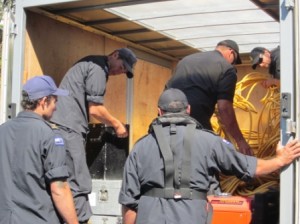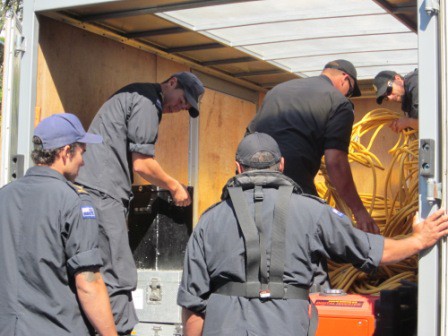
Raglan’s Coastguard volunteers were hard at work for another day taking Navy divers and their equipment out to the Navy’s dive support vessel, HMNZS Manawanui, which is now on location 30 km south west of Raglan. Raglan Coastguard expected to make several trips on Gallagher Rescue from Raglan Wharf to the crash site during the afternoon crossing the Raglan Bar each time with seas running at 2 metres. Seas at Gannet Island, the site of the crash area, have dropped slightly but are still dangerous running at 3.5 metres. It is predicted that seas at Gannet Island will drop to 2.6 metres on Saturday.
“What we’re dealing with is the recovery of two people believed to be inside an aircraft lying on the ocean floor off Gannet Island at a depth of 56m” said Incident controller, Sergeant Warren Shaw, of the Waikato Police Search and Rescue Squad said on Thursday night.
“This is near the optimum depth our Navy divers can operate at however on the plus side they have the right equipment, personnel and experience to ensure a successful conclusion to the operation.”

Mr Shaw said one of the strengths on being able to rely on the Navy’s expertise is that they provide plans and experience to meet a number of contingencies should the need arise.
“Dependent on weather and sea conditions we expect the Navy’s dive support vessel, HMNZS Manawanui, to arrive off the wreck site this morning.
“This vessel will be the focal point of our operation and we are guided by the Navy’s Operational Dive Team on how we will progress our activities but they have stressed to us there are a number of challenges.”
“To be able to do this successfully we need to be able to conduct our operation unhindered so we’re asking boaties and masters of vessels to ensure they respect the 500m radius exclusion zone around the crash site off Gannet Island.”
Safety of all personnel involved, respect for the deceased and a desire to return them to their loved ones was the driver behind a briefing last night attended by several agencies involved in the recovery of a downed aircraft lost off the Waikato coast. The three themes are the drivers of the complex multi-agency recovery operation.One of those challenges faced by the team is determining if the two occupants of the plane, Eric and Katherine Hertz, remain on board.
Mr Shaw said while the recovery is going on, local Iwi have placed a Rahui on the area.
“This is a mark of respect for those in the water and requires people to refrain from carrying out any action in that water and is in synergy with the objectives of our operation.
“Because the plane is upside down we haven’t been able to confirm the location of the bodies. To that end Police need to have a range of contingencies in place so in the worst case scenario, if they aren’t, we can locate them.
“Our primary objective is ensuring the safety of all our personnel involved and recovering Mr and Mrs Hertz in an as dignified manner as possible. People can best show their respect and support for the bereaved family by observing the Rahui and the 500m exclusion zone.”
HMNZS Manawanui fact sheet
HMNZS MANAWANUI is the Navy’s dive support vessel. She forms part of the Navy’s Littoral Warfare Support Group and provides an expert platform to support diving and mine counter-measure operations.
The dive support capabilities onboard MANAWANUI include a compression chamber, a diving bell, a 15 ton crane and workshop facilities including electric and gas welding equipment and a lathe. MANAWANUI also has a four point precision anchoring system, allowing her to accurately position herself for underwater operations.
The Navy’s Operational Dive team is often based on MANAWANUI. The team are trained for deep diving using mixed gas breathing apparatus, and are skilled in underwater demolition and unexploded ordnance disposal.
With a range of 5000 nautical miles MANAWANUI can undertake peacekeeping and maritime security missions around the New Zealand coast, South Pacific and South East Asia regions.

